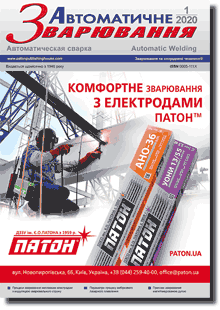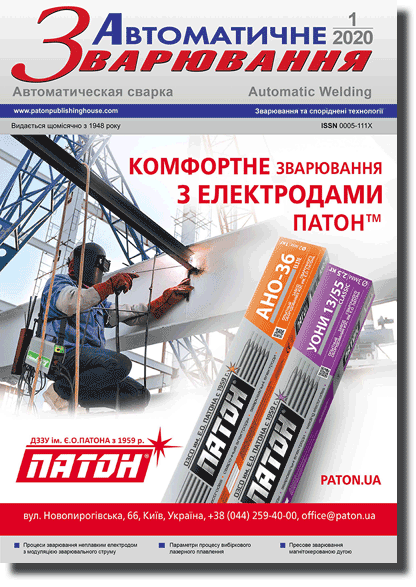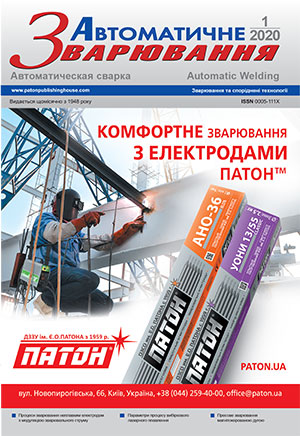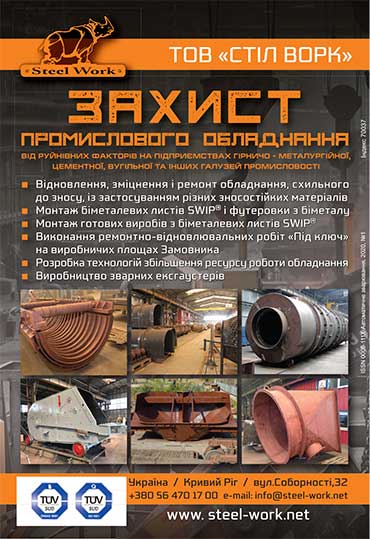| 2020 №01 (01) |
DOI of Article 10.37434/as2020.01.02 |
2020 №01 (03) |

"Avtomatychne Zvaryuvannya" (Automatic Welding), #1, 2020, pp.15-24
Numerical prediction of kinetics of the state of beam products of different thicknesses during layer-by-layer electron beam surfacing
O.S. Milenin1, O.A. Velikoivanenko1, S.S. Kozlitina1, S.M. Kandala1, A.E. Babenko2
1E.O. Paton Electric Welding Institute of the NAS of Ukraine, 11 Kazymyr Malevich Str., 03150, Kyiv, Ukraine. E-mail: office@paton.kiev.ua
2National Technical University of Ukraine «Igor Sikorsky Kyiv Polytechnic Institute», 37 Pobedy Ave., Kyiv-56, Ukraine
A complex of mathematical models and their computer means for numerical prediction of the kinetics of temperature fields, phase and structural states, mechanical stresses and deformations in layer-by-layer formation of typical products of titanium-based alloys was developed. On the typical examples of electron beam surfacing of T-shaped beam structures of titanium VT6 alloy produced with the help of xBeam 3D Metal Printer technology, the peculiarities of their kinetics depending on the technological parameters of production were investigated. The influence of the thickness of the substrate on regularities of the temperature field development during layer-by-layer formation of beam elements and on the structural state of the metal after complete cooling was shown. On the example of forming a thick-walled T-shape product it was shown, that an important factor, that allows obtaining a low level of residual stresses, is the optimization of the delay time between the surfacing of each of the beads to provide the conditions of uniform cooling of the structure. 11 Ref., 14 Fig.
Keywords: additive technologies, electron beam surfacing, xBeam 3D Metal Printer, mathematical modelling, macrostructure, mechanical properties, stress-strain state
Received: 21.11.2019
References
1. Edwards, P. et al. (2013). Electron beam additive manufacturing of titanium components: Properties and performance. J. of Manufacturing Sci. and Eng., 135(6). https://doi.org/10.1115/1.40257732. Juechter, V., Franke, M.M., Merenda, T. et al. (2018) Additive manufacturing of Ti-45Al-4Nb-C by selective electron beam melting for automotive applications. Additive Manufacturing, 22, 118-126. https://doi.org/10.1016/j.addma.2018.05.008
3. Dutta, B., Froes, F.H. (2016) Additive manufacturing of titanium alloys: State of the art, challenges and opportunities. Oxford, Butterworth-Heinemann. https://doi.org/10.1016/C2015-0-02470-4
4. Kovalchuk, D.V., Melnik, V.I., Melnik, I.V. (2017) New possibilities of additive manufacturing with xBeam 3D Metal Printing technology. In: Proc. of 8th Int. Conf. on Beam Technologies in Welding and Processing of Materials. Kyiv, 45-52. https://doi.org/10.15407/tpwj2017.12.03
5. Makhnenko, V.I. (2006) Safe service life of welded joints and assemblies of modern structures. Kyiv, Naukova Dumka [in Russian].
6. Polkin, I.S. (2006) Improvement of properties of metallic materials due to application of new technological processes. In: Advanced technologies of light and special alloys. Moscow, Fizmatlit, 66-73 [in Russian].
7. Sieniawski, J., Ziaja, W., Kubiak, K. (2013) Microstructure and mechanical properties of high strength two-phase titanium alloys. Titanium Alloys, 69-79. https://doi.org/10.5772/56197
8. Liu, S., Shin, Y.C. (2019) Additive manufacturing of Ti6Al4V alloy: A review. Materials and design, 164, 1-23. https://doi.org/10.1016/j.matdes.2018.107552
9. Patil, S., Kekade, S., Phapale, K. (2016) Effect of α and β phase volume fraction on machining characteristics of titanium alloy Ti6Al4V. In: Proc. of 16th Machining Innovations Conf. for Aerospace Industry, 65. https://doi.org/10.1016/j.promfg.2016.11.009
10. Velikoivanenko, Е.A., Milenin, A.S., Popov, A.V. et al. (2019) Methods of numerical forecasting of the working performance of welded structures on computers of hybrid architecture. Cybernetics and Systems Analysis, 55(1), 117-127. https://doi.org/10.1007/s10559-019-00117-8
11. Makhnenko, O.V., Milenin, A.S., Velikoivanenko, E.A. et al. (2017) Modelling of temperature fields and stress-strain state of small 3D sample in its layer-by-layer forming. The Paton Welding J., 3, 7-14. https://doi.org/10.15407/tpwj2017.03.02
Advertising in this issue:
The cost of subscription/purchase order journals or individual articles
| Journal/Currency | Annual Set | 1 issue printed |
1 issue |
one article |
| TPWJ/USD | 384 $ | 32 $ | 26 $ | 13 $ |
| TPWJ/EUR | 348 € | 29 € | 24 € | 12 € |
| TPWJ/UAH | 7200 UAH | 600 UAH | 600 UAH | 280 UAH |
| AS/UAH | 1800 UAH | 300 UAH | 300 UAH | 150 UAH |
| AS/USD | 192 $ | 32 $ | 26 $ | 13 $ |
| AS/EUR | 180 € | 30 € | 25 € | 12 € |
| SEM/UAH | 1200 UAH | 300 UAH | 300 UAH | 150 UAH |
| SEM/USD | 128 $ | 32 $ | 26 $ | 13 $ |
| SEM/EUR | 120 € | 30 € | 25 € | 12 € |
| TDNK/UAH | 1200 UAH | 300 UAH | 300 UAH | 150 UAH |
| TDNK/USD | 128 $ | 32 $ | 26 $ | 13 $ |
| TDNK/EUR | 120 € | 30 € | 25 € | 15 € |
AS = «Automatic Welding» - 6 issues per year;
TPWJ = «PATON WELDING JOURNAL» - 12 issues per year;
SEM = «Electrometallurgy Today» - 4 issues per year;
TDNK = «Technical Diagnostics and Non-Destructive Testing» - 4 issues per year.








